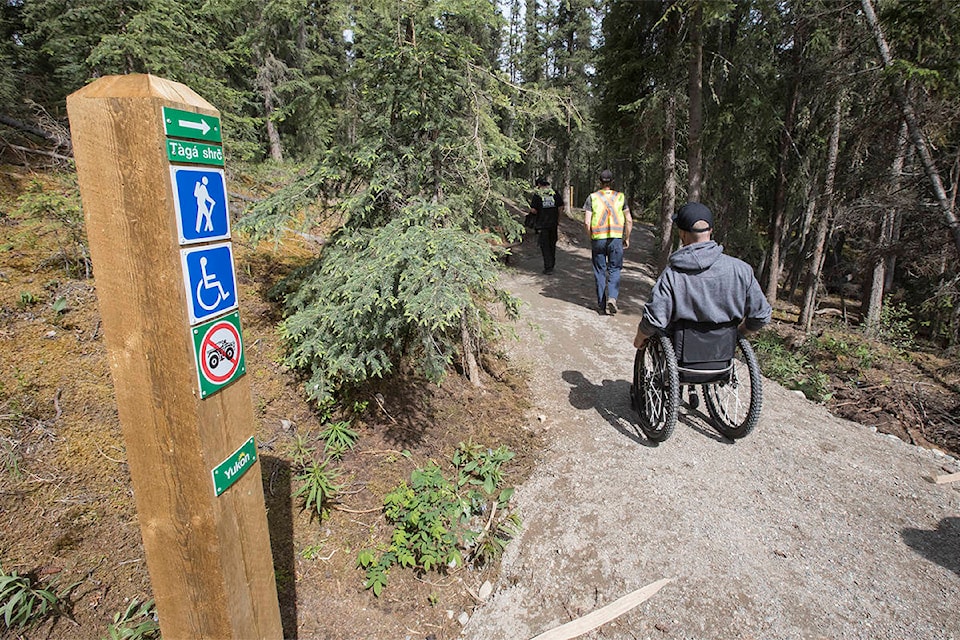The Yukon government’s second-ever wheelchair-accessible trail is now open for use, with first-of-its-kind interpretive signs in English, French and Southern Tutchone to guide visitors along the way.
Officials from the Yukon government, Ta’an Kwäch’än Council (TKC) and Kwanlin Dün First Nation (KDFN) were on-hand at the Wolf Creek campground to inaugurate the Tän Tágà Shro, or, “trail (to the) big river” in Southern Tutchone, on June 5.
The project was a collaboration between the three governments as well as the City of Whitehorse, bolstered by a funding grant from CanNor. The roughly kilometre-long trail, which was re-built by Singletrack to Success, begins in the heart of the campground and takes visitors through the woods and, eventually, to a scenic lookout and picnic area.
“I feel like this project for me represents some big initiatives we’ve been working on in the last few years that I’m very passionate about,” Yukon Parks interpreter planner Sara Nielsen said at the ceremony.
“… One of those is increasing accessibility so more people can enjoy the benefits of nature, and that starts off by removing the barriers to access it.”
The other big theme, Nielsen said, was Yukon Parks’ commitment “to trying to make Indigenous languages and place names and culture come alive on the land.”
“Indigenous languages have come from this land, from wherever you are, and the stories are so powerful,” she said.
TKC heritage technician Anne-Marie Miller said her First Nation was “very happy to have been a key partner in this initiative.”
“We proud to finally start to see Southern Tutchone and particularly, the Lake Laberge dialect, in and around the traditional territory,” he said. “Enhancing, preserving and protecting our language is critical. It is a fundamental part of who we are as Ta’an Kwäch’än.”
Acknowledging the “hard work” of TKC elder Nakhela (Hazel Bunbury), who provided the Southern Tutchone translations, Miller noted that 2019 is the International Year of Indigenous Languages, and the signs serve as an important educational tool.
“I look forward to continuing to see more Indigenous language efforts throughout our territory and working with the other governments and partners in promoting and educating about our nations and our language,” she said.
KDFN councillor Jessie Dawson also spoke about the importance of revitalizing Indigenous languages.
“I’m proud to witness the resurgence of First Nations languages in our young people and on signages throughout the city,” she said. “First Nation languages have been spoken on this land for thousands of years and we’re starting to speak our language again in public places, which is great to see.”
In an interview after the ribbon-cutting, Yukon athlete Darryl Tait, who uses wheelchair and served as the accessibility consultant for the project, recalled trying out the trail before the re-build and having to “abuse all of my wheelchair skills to be able to navigate my way through the woods and through the roots and up the steep terrain.”
“And to see it now, after … It was so much easier (to use), I didn’t break a sweat and I was honestly super excited to see the view, because it’s such a beautiful view at the end. I feel like everybody should be able to see that,” he said.
“I am super excited as far as, you know, being inclusive to everyone, being able to enter an environment that you would normally think is not accessible … But now, anybody can go at ease, whether you’re in a wheelchair, a walker, a cane, you know, visually, mobility, whatever, it’s all here.
“Everybody can go as a family, be together and feel equal, and I hope that there’s going to be more of it happening in the future and this is just a start of things to happen in the Yukon.”
The Yukon government’s first wheelchair-accessible trail was the Beaver Pond trail in Tombstone Territorial Park. The Yukon government is currently working on creating another accessible trail at the Pine Lake campground.
Contact Jackie Hong at jackie.hong@yukon-news.com
This story has been edited to clarify that Tän Tágà Shro is the Yukon government’s second accessible trail.
